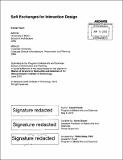| dc.contributor.advisor | Kevin Slavin. | en_US |
| dc.contributor.author | Farah, Kamal (Kamal Cristobal) | en_US |
| dc.contributor.other | Massachusetts Institute of Technology. Department of Architecture. Program in Media Arts and Sciences. | en_US |
| dc.date.accessioned | 2015-09-17T19:01:43Z | |
| dc.date.available | 2015-09-17T19:01:43Z | |
| dc.date.copyright | 2015 | en_US |
| dc.date.issued | 2015 | en_US |
| dc.identifier.uri | http://hdl.handle.net/1721.1/98642 | |
| dc.description | Thesis: S.M., Massachusetts Institute of Technology, School of Architecture and Planning, Program in Media Arts and Sciences, 2015. | en_US |
| dc.description | Cataloged from PDF version of thesis. | en_US |
| dc.description | Includes bibliographical references (pages 57-59). | en_US |
| dc.description.abstract | The boundaries and fabric of human experience are continuously redefined by microorganisms interacting at imperceptible scales. Though hidden, these systems condition our body and the environment we inhabit. Instruments such as microscopes and satellites have allowed us to observe scales of human experience, situating circumstances between those we effect and those effected by us. Advances in synthetic biology are enabling us to interact with this microscopic world in new and unforeseen ways. This thesis proposes using the new access we now have into this world, and with which we do not regularly interact, to experience our own world differently. Soft Exchanges are created through the design and development of a camera like instrument implementing the Bactograph protocol developed in 2005 by Jeffrey Tabor, Assistant Professor of Bioengineering at Rice University. Of the many advances in Synthetic Biology, a notable one has been that of Jeffrey Tabor and his laboratory in creating a new capability for Escherichia coli to detect light and produce high resolution chemical images as bacterial photographs. This work is furthered, to realize new interactions with the design and implementation of a biological instrument towards the development of Human Biological Interactions. | en_US |
| dc.description.statementofresponsibility | by Kamal Farah. | en_US |
| dc.format.extent | 59 pages | en_US |
| dc.language.iso | eng | en_US |
| dc.publisher | Massachusetts Institute of Technology | en_US |
| dc.rights | M.I.T. theses are protected by copyright. They may be viewed from this source for any purpose, but reproduction or distribution in any format is prohibited without written permission. See provided URL for inquiries about permission. | en_US |
| dc.rights.uri | http://dspace.mit.edu/handle/1721.1/7582 | en_US |
| dc.subject | Architecture. Program in Media Arts and Sciences. | en_US |
| dc.title | Soft exchanges for interaction design | en_US |
| dc.type | Thesis | en_US |
| dc.description.degree | S.M. | en_US |
| dc.contributor.department | Program in Media Arts and Sciences (Massachusetts Institute of Technology) | |
| dc.identifier.oclc | 920678108 | en_US |
